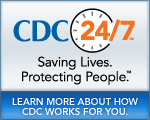This page is a historical archive and is no longer maintained.
For current information, please visit http://www.cy118119.com/media/
Media Statement
For Immediate Release: May 20, 2011
Contact: CDC Online Newsroom
(404) 639-3286
CDC Observes Lyme Disease Awareness Month
In recognition of Lyme Disease Awareness month, the Centers for Disease Control and Prevention reminds Americans to learn about this common tickborne disease and take steps to protect themselves if they live in or visit areas with Lyme disease activity.
Lyme disease is the most commonly reported vectorborne illness (or disease transmitted to humans by ticks, mosquitoes or fleas) in the United States, with nearly 30,000 confirmed cases reported in 2009. Between 1992 and 2009, the reported annual number of Lyme disease cases more than tripled, with children most at risk for the disease. Children are more at risk because they spend more time playing outdoors and in high grass or leaves, where the ticks that spread Lyme disease are found.
Lyme disease is transmitted to people through the bite of infected blacklegged ticks. These ticks are most active during May through July, so it's especially important that people living in affected regions take steps now to prevent Lyme disease when they go outside. About 95 percent of reported cases in 2009 were from just 12 states. In descending order of reported cases, they are: Pennsylvania, New Jersey, New York, Massachusetts, Connecticut, Wisconsin, Maryland, Minnesota, New Hampshire, Delaware, Maine and Virginia.
To prevent Lyme disease and other tickborne diseases, CDC recommends that people:
- Avoid areas with high grass and leaf litter and walk in the center of trails when hiking.
- Use repellent that contains 20 percent or more DEET on exposed skin for protection that lasts several hours. Parents should apply repellent to children; the American Academy of Pediatrics recommends products with up to 30 percent DEET for kids. Always follow product instructions!
- Use products that contain permethrin to treat clothing and gear, such as boots, pants, socks and tents or look for clothing pre-treated with permethrin.
- Bathe or shower as soon as possible after coming indoors to wash off and more easily find crawling ticks before they bite you.
- Conduct a full-body tick check using a hand-held or full-length mirror to view all parts of your body upon returning from tick-infested areas. Parents should help children check thoroughly for ticks. Remove any ticks right away.
Typical symptoms of Lyme disease include fever, headache, fatigue, and a large, expanding skin rash that may have a bull's-eye appearance. If left untreated, infection can spread to joints, the heart, and the nervous system. Anyone who develops a fever or a rash after being bitten by a tick or spending time in tick-infested areas should seek prompt medical care. Most patients with Lyme disease can be treated successfully with a few weeks' of antibiotics, especially if treated early.
Lyme disease prevention begins with recognizing the risks and taking action. For more information on Lyme disease, please visit www.cy118119.com/Lyme.
###
U.S. DEPARTMENT OF HEALTH AND HUMAN SERVICES
- Historical Document: May 20, 2011
- Content source: Office of the Associate Director for Communication, Division of News and Electronic Media
- Notice: Links to non-governmental sites do not necessarily represent the views of the CDC.
View Press Releases in
Contact Us:
- Centers for Disease Control and Prevention
1600 Clifton Rd
Atlanta, GA 30333 - 800-CDC-INFO
(800-232-4636)
TTY: (888) 232-6348 - Contact CDC-INFO


